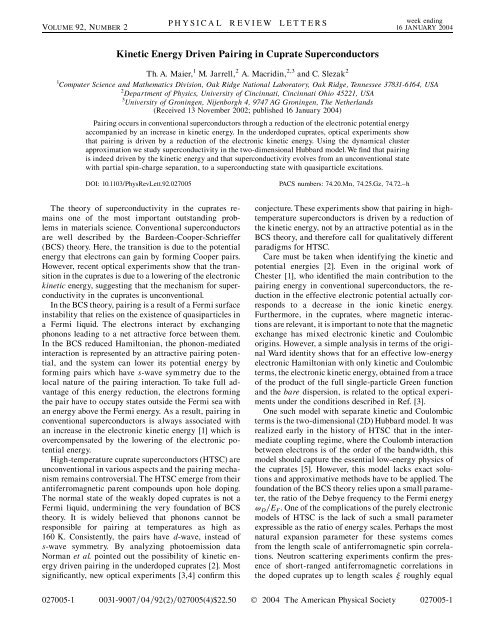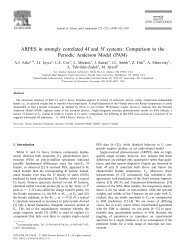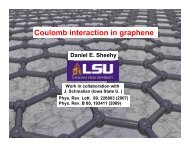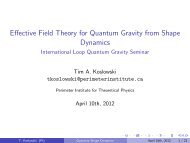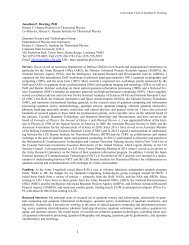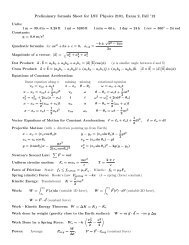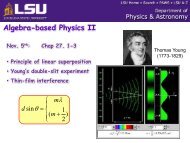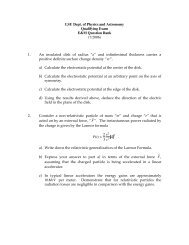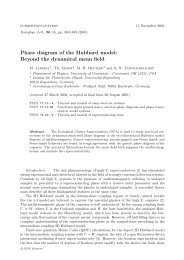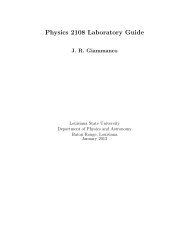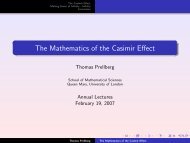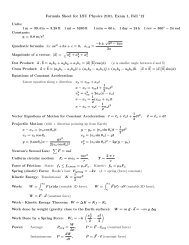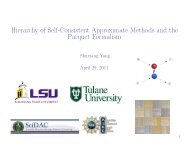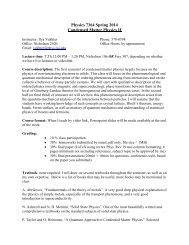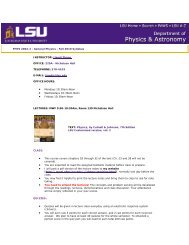Kinetic Energy Driven Pairing in Cuprate Superconductors
Kinetic Energy Driven Pairing in Cuprate Superconductors
Kinetic Energy Driven Pairing in Cuprate Superconductors
Create successful ePaper yourself
Turn your PDF publications into a flip-book with our unique Google optimized e-Paper software.
VOLUME 92, NUMBER 2<br />
<strong>K<strong>in</strong>etic</strong> <strong>Energy</strong> <strong>Driven</strong> <strong>Pair<strong>in</strong>g</strong> <strong>in</strong> <strong>Cuprate</strong> <strong>Superconductors</strong><br />
Th. A. Maier, 1 M. Jarrell, 2 A. Macrid<strong>in</strong>, 2,3 and C. Slezak 2<br />
1<br />
Computer Science and Mathematics Division, Oak Ridge National Laboratory, Oak Ridge, Tennessee 37831-6164, USA<br />
2<br />
Department of Physics, University of C<strong>in</strong>c<strong>in</strong>nati, C<strong>in</strong>c<strong>in</strong>nati Ohio 45221, USA<br />
3<br />
University of Gron<strong>in</strong>gen, Nijenborgh 4, 9747 AG Gron<strong>in</strong>gen, The Netherlands<br />
(Received 13 November 2002; published 16 January 2004)<br />
<strong>Pair<strong>in</strong>g</strong> occurs <strong>in</strong> conventional superconductors through a reduction of the electronic potential energy<br />
accompanied by an <strong>in</strong>crease <strong>in</strong> k<strong>in</strong>etic energy. In the underdoped cuprates, optical experiments show<br />
that pair<strong>in</strong>g is driven by a reduction of the electronic k<strong>in</strong>etic energy. Us<strong>in</strong>g the dynamical cluster<br />
approximation we study superconductivity <strong>in</strong> the two-dimensional Hubbard model. We f<strong>in</strong>d that pair<strong>in</strong>g<br />
is <strong>in</strong>deed driven by the k<strong>in</strong>etic energy and that superconductivity evolves from an unconventional state<br />
with partial sp<strong>in</strong>-charge separation, to a superconduct<strong>in</strong>g state with quasiparticle excitations.<br />
DOI: 10.1103/PhysRevLett.92.027005 PACS numbers: 74.20.Mn, 74.25.Gz, 74.72.–h<br />
The theory of superconductivity <strong>in</strong> the cuprates rema<strong>in</strong>s<br />
one of the most important outstand<strong>in</strong>g problems<br />
<strong>in</strong> materials science. Conventional superconductors<br />
are well described by the Bardeen-Cooper-Schrieffer<br />
(BCS) theory. Here, the transition is due to the potential<br />
energy that electrons can ga<strong>in</strong> by form<strong>in</strong>g Cooper pairs.<br />
However, recent optical experiments show that the transition<br />
<strong>in</strong> the cuprates is due to a lower<strong>in</strong>g of the electronic<br />
k<strong>in</strong>etic energy, suggest<strong>in</strong>g that the mechanism for superconductivity<br />
<strong>in</strong> the cuprates is unconventional.<br />
In the BCS theory, pair<strong>in</strong>g is a result of a Fermi surface<br />
<strong>in</strong>stability that relies on the existence of quasiparticles <strong>in</strong><br />
a Fermi liquid. The electrons <strong>in</strong>teract by exchang<strong>in</strong>g<br />
phonons lead<strong>in</strong>g to a net attractive force between them.<br />
In the BCS reduced Hamiltonian, the phonon-mediated<br />
<strong>in</strong>teraction is represented by an attractive pair<strong>in</strong>g potential,<br />
and the system can lower its potential energy by<br />
form<strong>in</strong>g pairs which have s-wave symmetry due to the<br />
local nature of the pair<strong>in</strong>g <strong>in</strong>teraction. To take full advantage<br />
of this energy reduction, the electrons form<strong>in</strong>g<br />
the pair have to occupy states outside the Fermi sea with<br />
an energy above the Fermi energy. As a result, pair<strong>in</strong>g <strong>in</strong><br />
conventional superconductors is always associated with<br />
an <strong>in</strong>crease <strong>in</strong> the electronic k<strong>in</strong>etic energy [1] which is<br />
overcompensated by the lower<strong>in</strong>g of the electronic potential<br />
energy.<br />
High-temperature cuprate superconductors (HTSC) are<br />
unconventional <strong>in</strong> various aspects and the pair<strong>in</strong>g mechanism<br />
rema<strong>in</strong>s controversial. The HTSC emerge from their<br />
antiferromagnetic parent compounds upon hole dop<strong>in</strong>g.<br />
The normal state of the weakly doped cuprates is not a<br />
Fermi liquid, underm<strong>in</strong><strong>in</strong>g the very foundation of BCS<br />
theory. It is widely believed that phonons cannot be<br />
responsible for pair<strong>in</strong>g at temperatures as high as<br />
160 K. Consistently, the pairs have d-wave, <strong>in</strong>stead of<br />
s-wave symmetry. By analyz<strong>in</strong>g photoemission data<br />
Norman et al. po<strong>in</strong>ted out the possibility of k<strong>in</strong>etic energy<br />
driven pair<strong>in</strong>g <strong>in</strong> the underdoped cuprates [2]. Most<br />
significantly, new optical experiments [3,4] confirm this<br />
PHYSICAL REVIEW LETTERS week end<strong>in</strong>g<br />
16 JANUARY 2004<br />
conjecture. These experiments show that pair<strong>in</strong>g <strong>in</strong> hightemperature<br />
superconductors is driven by a reduction of<br />
the k<strong>in</strong>etic energy, not by an attractive potential as <strong>in</strong> the<br />
BCS theory, and therefore call for qualitatively different<br />
paradigms for HTSC.<br />
Care must be taken when identify<strong>in</strong>g the k<strong>in</strong>etic and<br />
potential energies [2]. Even <strong>in</strong> the orig<strong>in</strong>al work of<br />
Chester [1], who identified the ma<strong>in</strong> contribution to the<br />
pair<strong>in</strong>g energy <strong>in</strong> conventional superconductors, the reduction<br />
<strong>in</strong> the effective electronic potential actually corresponds<br />
to a decrease <strong>in</strong> the ionic k<strong>in</strong>etic energy.<br />
Furthermore, <strong>in</strong> the cuprates, where magnetic <strong>in</strong>teractions<br />
are relevant, it is important to note that the magnetic<br />
exchange has mixed electronic k<strong>in</strong>etic and Coulombic<br />
orig<strong>in</strong>s. However, a simple analysis <strong>in</strong> terms of the orig<strong>in</strong>al<br />
Ward identity shows that for an effective low-energy<br />
electronic Hamiltonian with only k<strong>in</strong>etic and Coulombic<br />
terms, the electronic k<strong>in</strong>etic energy, obta<strong>in</strong>ed from a trace<br />
of the product of the full s<strong>in</strong>gle-particle Green function<br />
and the bare dispersion, is related to the optical experiments<br />
under the conditions described <strong>in</strong> Ref. [3].<br />
One such model with separate k<strong>in</strong>etic and Coulombic<br />
terms is the two-dimensional (2D) Hubbard model. It was<br />
realized early <strong>in</strong> the history of HTSC that <strong>in</strong> the <strong>in</strong>termediate<br />
coupl<strong>in</strong>g regime, where the Coulomb <strong>in</strong>teraction<br />
between electrons is of the order of the bandwidth, this<br />
model should capture the essential low-energy physics of<br />
the cuprates [5]. However, this model lacks exact solutions<br />
and approximative methods have to be applied. The<br />
foundation of the BCS theory relies upon a small parameter,<br />
the ratio of the Debye frequency to the Fermi energy<br />
! D=E F. One of the complications of the purely electronic<br />
models of HTSC is the lack of such a small parameter<br />
expressible as the ratio of energy scales. Perhaps the most<br />
natural expansion parameter for these systems comes<br />
from the length scale of antiferromagnetic sp<strong>in</strong> correlations.<br />
Neutron scatter<strong>in</strong>g experiments confirm the presence<br />
of short-ranged antiferromagnetic correlations <strong>in</strong><br />
the doped cuprates up to length scales roughly equal<br />
027005-1 0031-9007=04=92(2)=027005(4)$22.50 © 2004 The American Physical Society 027005-1
VOLUME 92, NUMBER 2<br />
to the mean distance between holes, or roughly one lattice<br />
spac<strong>in</strong>g <strong>in</strong> the optimally doped cuprates [6]. In the dynamical<br />
cluster approximation [7–10] (DCA) we take<br />
advantage of the short length scale of antiferromagnetic<br />
correlations to map the orig<strong>in</strong>al lattice model onto a<br />
periodic cluster with l<strong>in</strong>ear size Lc embedded <strong>in</strong> a self-<br />
2 consistent host and use =Lc [8] as the small parameter.<br />
As a result, dynamical correlations up to a range Lc are<br />
treated accurately while the physics on longer length<br />
scales is described on a mean-field level. We solve the<br />
cluster problem us<strong>in</strong>g quantum Monte Carlo and obta<strong>in</strong><br />
dynamics from the maximum entropy method [11].<br />
We <strong>in</strong>vestigate the nature of the superconduct<strong>in</strong>g phase<br />
transition of the conventional 2D Hubbard model on a<br />
square lattice. The model is characterized by a hopp<strong>in</strong>g<br />
<strong>in</strong>tegral t between nearest neighbor sites and a Coulomb<br />
repulsion U two electrons feel when resid<strong>in</strong>g on the same<br />
site. As the energy scale we set t 0:25 eV so that the<br />
bandwidth W 8t 2eV. We simulate the superconduct<strong>in</strong>g<br />
and correspond<strong>in</strong>g normal state solutions down<br />
to temperatures T 0:5Tc and compare their respective<br />
k<strong>in</strong>etic and potential energies. To obta<strong>in</strong> the normal state<br />
solution we suppress superconductivity by not allow<strong>in</strong>g<br />
for any symmetry break<strong>in</strong>g <strong>in</strong> our representation.<br />
To illustrate the typical BCS behavior we study the<br />
superconduct<strong>in</strong>g <strong>in</strong>stability <strong>in</strong> the negative U, i.e., attractive<br />
Hubbard model, which for jUj W is expected to<br />
show BCS behavior. Because of the local nature of the<br />
attractive potential U between electrons, the superconduct<strong>in</strong>g<br />
order parameter has s-wave symmetry and hence<br />
s<strong>in</strong>gle-site DCA simulations (Nc 1) can capture the<br />
mean-field behavior of this transition. Figure 1 shows<br />
our Nc 1 data for the negative U model for U<br />
0:375W at dop<strong>in</strong>g 0:05. As expected, pair<strong>in</strong>g is<br />
k<strong>in</strong>etic energy<br />
potential energy<br />
-0.360<br />
Tc -0.364<br />
-0.368<br />
-0.372<br />
-0.376<br />
NS<br />
SC<br />
-0.060<br />
Tc -0.064<br />
-0.068<br />
-0.072<br />
-0.076<br />
NS<br />
SC<br />
-0.080<br />
0 0.02 0.04 0.06 0.08<br />
T<br />
FIG. 1. <strong>K<strong>in</strong>etic</strong> (top) and potential (bottom) energies of the<br />
normal (NS) and superconduct<strong>in</strong>g (SC) states <strong>in</strong> the negative U<br />
Hubbard model (U 0:375W) for N c 1 as a function of<br />
temperature across the superconduct<strong>in</strong>g transition at T c<br />
0:051 as <strong>in</strong>dicated by the dashed l<strong>in</strong>e at 5% dop<strong>in</strong>g. <strong>Pair<strong>in</strong>g</strong><br />
is accompanied by a reduction of the electronic potential<br />
energy and by a slight <strong>in</strong>crease of the k<strong>in</strong>etic energy.<br />
PHYSICAL REVIEW LETTERS week end<strong>in</strong>g<br />
16 JANUARY 2004<br />
driven by a reduction of the electronic potential energy,<br />
while the k<strong>in</strong>etic energy slightly <strong>in</strong>creases <strong>in</strong> the superconduct<strong>in</strong>g<br />
state.<br />
We now turn to the actual focus of this Letter, the<br />
positive U, i.e., repulsive Hubbard model. We set the<br />
Coulomb repulsion equal to the bandwidth, U W, to<br />
study the relevant, <strong>in</strong>termediate coupl<strong>in</strong>g regime for a<br />
description of the HTSC. We explore the dynamics on<br />
short length-scales by sett<strong>in</strong>g the cluster size to N c<br />
the smallest cluster size which allows for a superconduct<strong>in</strong>g<br />
phase with d-wave order parameter. We have previously<br />
shown that this cluster size is large enough to<br />
capture the qualitative low-energy physics of the cuprate<br />
superconductors [12,13], while the solution reta<strong>in</strong>s some<br />
mean-field behavior: We f<strong>in</strong>d antiferromagnetism and<br />
pseudogap behavior at low dop<strong>in</strong>g and a transition to a<br />
superconduct<strong>in</strong>g state with d-wave symmetry at low temperatures<br />
over an extended range of f<strong>in</strong>ite dop<strong>in</strong>gs.<br />
In this Letter, we are <strong>in</strong>terested <strong>in</strong> the nature of the<br />
superconduct<strong>in</strong>g phase transition. We study whether pair<strong>in</strong>g<br />
<strong>in</strong> the repulsive Hubbard model is driven by the<br />
existence of an attractive pair<strong>in</strong>g potential as <strong>in</strong> the<br />
BCS theory and weak coupl<strong>in</strong>g attractive Hubbard model,<br />
or a lower<strong>in</strong>g of the k<strong>in</strong>etic energy. In Fig. 2 we present<br />
the k<strong>in</strong>etic (top) and potential (bottom) energies as a<br />
function of temperature at low dop<strong>in</strong>g ( 0:05) onthe<br />
left panel and high dop<strong>in</strong>g ( 0:20) on the right panel.<br />
The correspond<strong>in</strong>g values of the critical temperatures T c<br />
are <strong>in</strong>dicated by the vertical dotted l<strong>in</strong>es. For both dop<strong>in</strong>g<br />
levels, the k<strong>in</strong>etic energy of the superconduct<strong>in</strong>g state is<br />
lower than the k<strong>in</strong>etic energy of the correspond<strong>in</strong>g normal<br />
state solution. This contradicts the behavior expected<br />
from BCS theory where the k<strong>in</strong>etic energy of the superconduct<strong>in</strong>g<br />
state is always slightly <strong>in</strong>creased compared to<br />
the normal state. In addition, the potential energies of the<br />
normal and superconduct<strong>in</strong>g states are almost identical,<br />
k<strong>in</strong>etic energy<br />
potential energy<br />
-0.270<br />
-0.272<br />
-0.274<br />
-0.276<br />
-0.278<br />
-0.380<br />
-0.382<br />
-0.384<br />
δ=0.05<br />
δ=0.05<br />
T c<br />
NS<br />
SC<br />
-0.386<br />
NS -0.250<br />
NS<br />
SC<br />
SC<br />
-0.388<br />
-0.252<br />
0 0.01 0.02 0.03 0.04 0 0.01 0.02 0.03 0.04<br />
T<br />
T c<br />
-0.306<br />
-0.308<br />
-0.310<br />
-0.312<br />
-0.314<br />
-0.244<br />
-0.246<br />
-0.248<br />
δ=0.20 T c<br />
δ=0.20 T c<br />
T<br />
NS<br />
SC<br />
FIG. 2. <strong>K<strong>in</strong>etic</strong> (top) and potential (bottom) energies of the<br />
repulsive Hubbard model <strong>in</strong> the normal (NS) and superconduct<strong>in</strong>g<br />
(SC) states as a function of temperature for low dop<strong>in</strong>g<br />
( 0:05, left) and high dop<strong>in</strong>g ( 0:20, right). The vertical<br />
dotted l<strong>in</strong>es represent the value of T c. <strong>Pair<strong>in</strong>g</strong> is mediated by a<br />
reduction of the k<strong>in</strong>etic energy.<br />
027005-2 027005-2<br />
4,
VOLUME 92, NUMBER 2<br />
<strong>in</strong>dicat<strong>in</strong>g that pair<strong>in</strong>g is not driven by the potential<br />
energy. The magnitude of the k<strong>in</strong>etic energy lower<strong>in</strong>g at<br />
low dop<strong>in</strong>g, measured relative to the transition temperature,<br />
is roughly E k<strong>in</strong>=k BT c 0:18, <strong>in</strong> good agreement<br />
with the experimental estimate of E k<strong>in</strong>=k BT c<br />
1 meV=k B66 K 0:18. At 0:20, the lower<strong>in</strong>g of the<br />
k<strong>in</strong>etic energy is slightly less compared with 0:05.We<br />
conclude that superconductivity <strong>in</strong> the Hubbard model is<br />
driven by a lower<strong>in</strong>g of the k<strong>in</strong>etic energy with a magnitude<br />
that decreases as dop<strong>in</strong>g <strong>in</strong>creases.<br />
What could be the underly<strong>in</strong>g microscopic mechanism<br />
for the observed k<strong>in</strong>etic energy driven pair<strong>in</strong>g <strong>in</strong> HTSC<br />
and our simulation? Because of the vic<strong>in</strong>ity of the superconduct<strong>in</strong>g<br />
phase to antiferromagnetic order<strong>in</strong>g, it is<br />
widely believed that short-ranged antiferromagnetic<br />
sp<strong>in</strong> correlations are responsible for pair<strong>in</strong>g <strong>in</strong> the cuprates.<br />
This is the essential idea beh<strong>in</strong>d two pair<strong>in</strong>g models<br />
which predict the experimentally observed lower<strong>in</strong>g of<br />
the electronic k<strong>in</strong>etic energy. The first one relies on the<br />
existence of quasiparticles and is partially based on studies<br />
[14–17] of the motion of holes <strong>in</strong> an antiferromagnetic<br />
background which date back to the early work of<br />
Br<strong>in</strong>kman and Rice [18]. The motion of a s<strong>in</strong>gle hole is<br />
<strong>in</strong>hibited because it creates a str<strong>in</strong>g of broken antiferromagnetic<br />
bonds. Based on this picture, it is argued that<br />
two holes can decrease their k<strong>in</strong>etic energy by travel<strong>in</strong>g<br />
together, <strong>in</strong> a coherent motion, i.e., by form<strong>in</strong>g Cooper<br />
pairs. Hirsch’s discussion of k<strong>in</strong>etic energy driven superconductivity<br />
[19] is consistent with this picture. The<br />
second idea, due to Anderson, <strong>in</strong>volves sp<strong>in</strong>-charge separation<br />
with<strong>in</strong> a resonat<strong>in</strong>g valence bond (RVB) picture<br />
[20]. Because of strong antiferromagnetic correlations,<br />
sp<strong>in</strong>s pair <strong>in</strong>to short-ranged s<strong>in</strong>glets at a temperature T<br />
much higher than the superconduct<strong>in</strong>g transition temperature<br />
T c. This leads to a pseudogap <strong>in</strong> the electronic<br />
excitation spectrum and consequently to an <strong>in</strong>crease <strong>in</strong><br />
k<strong>in</strong>etic energy. Contrary to the quasiparticle picture, the<br />
elementary excitations of this state are sp<strong>in</strong> 1=2 charge<br />
neutral Fermions called sp<strong>in</strong>ons, and sp<strong>in</strong> 0 bosons called<br />
holons. At T c the holons become coherent and recomb<strong>in</strong>e<br />
with the sp<strong>in</strong>ons, form<strong>in</strong>g electrons which pair and render<br />
the system superconduct<strong>in</strong>g. Frustrated k<strong>in</strong>etic energy is<br />
then recovered [21].<br />
The first picture relies on the existence of quasiparticles,<br />
which <strong>in</strong> the Fermi-liquid concept correspond<br />
one to one to with those of a Fermi gas and thus have<br />
charge and sp<strong>in</strong>. Anderson’s RVB scenario, on the other<br />
hand, is based on the concept of sp<strong>in</strong>-charge separation<br />
and predicts quasifree charge excitations, the holons. To<br />
dist<strong>in</strong>guish between these two models we <strong>in</strong>vestigate the<br />
low-energy quasiparticle and charge excitations <strong>in</strong> the<br />
Hubbard model by calculat<strong>in</strong>g the s<strong>in</strong>gle-particle spectral<br />
function A k;! and the dynamic charge susceptibility,<br />
respectively. Our result for A k;! <strong>in</strong> the weakly doped<br />
system ( 0:05) for the temperature T 0:022 below<br />
the pseudogap temperature T and slightly above the<br />
critical temperature T c is presented <strong>in</strong> the left panel of<br />
PHYSICAL REVIEW LETTERS week end<strong>in</strong>g<br />
16 JANUARY 2004<br />
Fig. 3. While coherent quasiparticle peaks exist along<br />
! M, a pseudogap, i.e., a partial suppression of lowenergy<br />
spectral weight is seen near X ; 0 at the<br />
Fermi energy (! 0). S<strong>in</strong>ce the superconduct<strong>in</strong>g order<br />
parameter has a d-wave form, this is the region <strong>in</strong> k space<br />
where Cooper pairs are formed. This clearly <strong>in</strong>dicates that<br />
no quasiparticles <strong>in</strong> the normal state contribute to pair<strong>in</strong>g.<br />
In the right panel of Fig. 3 we show the imag<strong>in</strong>ary part of<br />
the local dynamic charge susceptibility 00<br />
c ! divided by<br />
the frequency for different temperatures. The low frequency<br />
behavior of this quantity provides <strong>in</strong>sight <strong>in</strong> the<br />
low-energy charge excitations. As the temperature decreases,<br />
this quantity develops a strong peak at zero<br />
frequency, <strong>in</strong>dicat<strong>in</strong>g the emergence of coherent charge<br />
excitations.<br />
S<strong>in</strong>ce A k;! represents quasiparticle excitations<br />
which have both charge and sp<strong>in</strong>, it follows from the<br />
simultaneous emergence of a pseudogap <strong>in</strong> A k;! and<br />
the development of coherent charge excitations that the<br />
low-energy sp<strong>in</strong> excitations must be suppressed. And <strong>in</strong>deed,<br />
our results for the sp<strong>in</strong> susceptibility at the antiferromagnetic<br />
wave vector ; (not shown) display this<br />
suppression of sp<strong>in</strong> excitations. Thus, at temperatures<br />
below the crossover temperature T ? sp<strong>in</strong> and charge<br />
degrees of freedom behave qualitatively differently, suggest<strong>in</strong>g<br />
sp<strong>in</strong> and charge separation.<br />
Figure 4 shows the behavior of the density of states<br />
N ! 1=N P kA k;! (left panel), charge (center<br />
panel), and sp<strong>in</strong> susceptibility (right panel) at 5% dop<strong>in</strong>g<br />
as the temperature decreases below the superconduct<strong>in</strong>g<br />
transition temperature T c<br />
0:0218. The density of states<br />
and the sp<strong>in</strong> susceptibility change smoothly across the<br />
superconduct<strong>in</strong>g phase transition. The pseudogap <strong>in</strong> both<br />
quantities changes to a superconduct<strong>in</strong>g gap [22] below<br />
A(k,ω) [1/eV]<br />
-2 -1 0<br />
ω [eV]<br />
1<br />
Γ<br />
2<br />
Γ<br />
X<br />
Μ<br />
χ’’ c (ω)/ω [1/eV]<br />
0.5<br />
0.45<br />
0.4<br />
0.35<br />
0.3<br />
0.25<br />
0.2<br />
0.15<br />
0.1<br />
0.05<br />
T=0.067<br />
T=0.039<br />
T=0.022<br />
0<br />
0 0.2 0.4 0.6 0.8 1<br />
ω [eV]<br />
FIG. 3. The low-energy s<strong>in</strong>gle-particle spectral function<br />
A k;! at temperature T 0:022 along high-symmetry directions<br />
<strong>in</strong> the Brillou<strong>in</strong> zone between 0; 0 , X ; 0 ,and<br />
M ; (left) and the imag<strong>in</strong>ary part of the local charge<br />
susceptibility over the frequency (right) at weak dop<strong>in</strong>g (<br />
0:05) for different temperatures. While a pseudogap exists <strong>in</strong><br />
A k;! , a peak develops at zero frequency <strong>in</strong> the charge<br />
susceptibility.<br />
027005-3 027005-3
VOLUME 92, NUMBER 2<br />
density of states [1/eV]<br />
1.2<br />
1<br />
0.8<br />
0.6<br />
0.4<br />
0.2<br />
T=0.022<br />
T=0.019<br />
T=0.011<br />
0<br />
-0.4 -0.2 0<br />
ω [eV]<br />
0.2 0.4<br />
χ’’ c (ω)/ω [1/eV]<br />
0.6<br />
0.5<br />
0.4<br />
0.3<br />
0.2<br />
0.1<br />
T=0.022<br />
T=0.019<br />
T=0.011<br />
0<br />
0 0.2 0.4 0.6 0.8<br />
ω [eV]<br />
1<br />
0<br />
0 0.2 0.4 0.6 0.8<br />
ω [eV]<br />
1<br />
T c. However, s<strong>in</strong>ce the charge susceptibility is peaked at<br />
zero frequency even slightly above T c, it changes abruptly<br />
upon pair<strong>in</strong>g to show the same behavior as the sp<strong>in</strong><br />
susceptibility, <strong>in</strong>clud<strong>in</strong>g the superconduct<strong>in</strong>g gap at low<br />
frequencies. Remarkably, well below T c all quantities<br />
display narrow peaks at ! 0:1 eV delimit<strong>in</strong>g the<br />
superconduct<strong>in</strong>g gap. This clearly <strong>in</strong>dicates the formation<br />
of quasiparticles below T c.<br />
These results may be <strong>in</strong>terpreted with<strong>in</strong> a sp<strong>in</strong>charge<br />
separated picture similar to that described <strong>in</strong><br />
Anderson’s RVB theory. The pair<strong>in</strong>g of sp<strong>in</strong>s <strong>in</strong> s<strong>in</strong>glets<br />
below the crossover temperature T ? results <strong>in</strong> the<br />
suppression of low-energy sp<strong>in</strong> excitations and consequently<br />
<strong>in</strong> a pseudogap <strong>in</strong> the density of states. The<br />
holons, or charge excitations are quasifree as <strong>in</strong>dicated<br />
by the zero-frequency peak <strong>in</strong> the charge susceptibility.<br />
Well below the transition sp<strong>in</strong> and charge<br />
degrees of freedom recomb<strong>in</strong>e, form<strong>in</strong>g electrons<br />
which pair. Frustrated k<strong>in</strong>etic energy is recovered as<br />
<strong>in</strong>dicated by the reduction of the k<strong>in</strong>etic energy as the<br />
system goes superconduct<strong>in</strong>g. However, s<strong>in</strong>ce sp<strong>in</strong>ons<br />
are not observables <strong>in</strong> our calculation, their existence<br />
cannot be directly addressed. Furthermore, s<strong>in</strong>ce the<br />
DCA treats long-ranged correlations with a s<strong>in</strong>gleparticle<br />
mean-field host, we can only have sp<strong>in</strong>-charge<br />
separation at short time and length scales with<strong>in</strong> the<br />
cluster. It is <strong>in</strong>terest<strong>in</strong>g to note that a weak shoulder<br />
appears <strong>in</strong> the charge susceptibility at ! 0:4 zJ,<br />
where z is the coord<strong>in</strong>ation number and J 4t 2 =U the<br />
antiferromagnetic coupl<strong>in</strong>g between neighbor<strong>in</strong>g sp<strong>in</strong>s.<br />
This observation might be <strong>in</strong>terpreted as a remanence<br />
of residual sp<strong>in</strong>-charge coupl<strong>in</strong>g.<br />
Us<strong>in</strong>g the dynamical cluster approximation we f<strong>in</strong>d a<br />
k<strong>in</strong>etic energy driven <strong>in</strong>stability <strong>in</strong> the 2D Hubbard<br />
model, consistent with recent optical experiments. The<br />
transition is from a state with partial sp<strong>in</strong>-charge separation<br />
to a d-wave superconduct<strong>in</strong>g state with quasiparticle<br />
excitations.<br />
χ’’ s (ω)/ω [1/eV]<br />
30<br />
25<br />
20<br />
15<br />
10<br />
5<br />
T=0.022<br />
T=0.019<br />
T=0.011<br />
FIG. 4. The density of states (left), local dynamic charge<br />
susceptibility (center), and local dynamic sp<strong>in</strong> susceptibility<br />
(right) when 0:05 and T c 0:0218. Note that for T T c<br />
all quantities display a narrow peak delimit<strong>in</strong>g the superconduct<strong>in</strong>g<br />
gap, <strong>in</strong>dicat<strong>in</strong>g the formation of quasiparticles.<br />
PHYSICAL REVIEW LETTERS week end<strong>in</strong>g<br />
16 JANUARY 2004<br />
We acknowledge useful conversations with<br />
G. Baskaran,W. Putikka, and G. Sawatzky. This research<br />
was supported by the NSF Grant No. DMR-0073308, and<br />
used resources of the Center for Computational Sciences<br />
at Oak Ridge National Laboratory. Part of this research<br />
was performed by T. M. as staff member at the Oak Ridge<br />
National Laboratory, managed by UT-Battelle, LLC, for<br />
the U.S. Department of <strong>Energy</strong> under Contract No. DE-<br />
AC05-00OR22725.<br />
[1] G. Chester, Phys. Rev. 103, 1693 (1956).<br />
[2] M. R. Norman, M. Randeria, B. Jankó, and J.C.<br />
Campuzano, Phys. Rev. B 61, 14 742 (2000).<br />
[3] H. J. A. Molegraaf, C. Presura, D. van der Marel, P. H.<br />
Kes, and M. Li, Science 295, 2239 (2002).<br />
[4] A. F. Santander-Syro, R. P. S. M. Lobo, N. Bontemps,<br />
Z. Konstant<strong>in</strong>ovic, Z. Z. Li, and H. Raffy, cond-mat/<br />
0111539.<br />
[5] P.W. Anderson, The Theory of Superconductivity <strong>in</strong><br />
the High-T c <strong>Cuprate</strong>s (Pr<strong>in</strong>ceton University Press,<br />
Pr<strong>in</strong>ceton, NJ, 1997).<br />
[6] T. R. Thurston et al., Phys. Rev. B 40, 4585 (1989).<br />
[7] M. H. Hettler, A. N. Tahvildar-Zadeh, M. Jarrell,<br />
T. Pruschke, and H. R. Krishnamurthy, Phys. Rev. B<br />
58, R7475 (1998).<br />
[8] M. H. Hettler, M. Mukherjee, M. Jarrell, and H. R.<br />
Krishnamurthy, Phys. Rev. B 61, 12739 (2000).<br />
[9] T. Maier, M. Jarrell, T. Pruschke, and J. Keller, Eur. Phys.<br />
J. B 13, 613 (2000).<br />
[10] M. Jarrell and H. R. Krishnamurthy, Phys. Rev. B 63,<br />
125102 (2001).<br />
[11] M. Jarrell, T. Maier, C. Huscroft, and S. Moukouri, Phys.<br />
Rev. B 64, 195130 (2001).<br />
[12] M. Jarrell, T. Maier, M. H. Hettler, and A. N.<br />
Tahvildarzadeh, Europhys. Lett. 56, 563 (2001).<br />
[13] T. Maier, M. Jarrell, T. Pruschke, and J. Keller, Phys.<br />
Rev. Lett. 85, 1524 (2000).<br />
[14] J. E. Hirsch, Phys. Rev. Lett. 59, 228 (1987).<br />
[15] J. Bonca, P. Prelovsek, and I. Sega, Phys. Rev. B 39,7074<br />
(1989).<br />
[16] E. Dagotto, J. Riera, and A. P. Young, Phys. Rev. B 42,<br />
2347 (1990).<br />
[17] T. Barnes, A. E. Jacobs, M. D. Kovarik, and W. G.<br />
Macready, Phys. Rev. B 45, 256 (1992).<br />
[18] W. F. Br<strong>in</strong>kman and T. M. Rice, Phys. Rev. B 2, 1324<br />
(1970).<br />
[19] J. E. Hirsch, Science 295, 2226 (2002).<br />
[20] P.W. Anderson, Science 235, 1196 (1987).<br />
[21] G. Baskaran, Int. J. Mod. Phys. B 14, 2117 (2000).<br />
[22] Note that due to the f<strong>in</strong>ite resolution <strong>in</strong> momentum space,<br />
the DCA underestimates low-energy spectral weight <strong>in</strong><br />
superconductors where the gap has nodes on the Fermi<br />
surface. As a result we f<strong>in</strong>d a fully developed gap at<br />
low temperatures <strong>in</strong>stead of a density of states that<br />
vanishes l<strong>in</strong>early <strong>in</strong> frequency as expected for a<br />
d-wave superconductor.<br />
027005-4 027005-4


